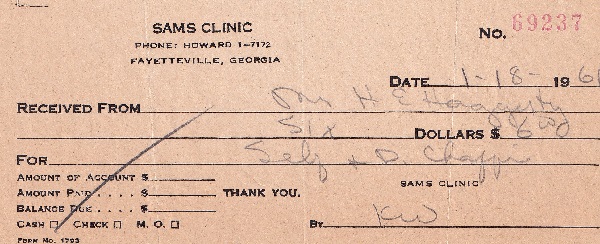
The image above is a receipt I found tucked into my baby book. My grandfather and I both saw Dr. Sams on that visit. I was not quite six months old, and my grandfather was 70, so Dr. Sams had to do it all. The total cost of the two visits was $6. I have another receipt where only I saw the doctor, and it was $3. Yes, times have changed.
In the old days of the 1960s, there was no urgent care around here. Doctor’s offices were open during the day on weekdays and Saturday mornings. There were no appointments, and it was first-come, first-serve unless you had a severe emergency. On one fine Saturday afternoon, I found a few scraps of wood and some nails and was building a ‘tree house’ (picture a platform in a tree, like a deer stand). Somehow I managed to fall from the tree, and my chin caught a rough pine tree limb on the way down. I ran home, thinking I would surely die from all the blood loss. Daddy convinced me that I would live, but I would need some stitches. So, he called Dr. Sams, and he met us at his office. He even brought one of his sons to watch/assist. I do not doubt that many Saturdays and Sundays were interrupted for Dr. Sams similarly, but he seemed very matter of fact about it.
Later on, after I had been married a few years, I was at his office for some minor thing, and he asked me if I had any children yet. I said no and that we weren’t really ready for that. He told me that if I waited until I was ready, I would never have any. I would find out just how true that was not long after that. Dr. Sams wrote several books, and in one of them, he noted that the father in the book said, “He’s a good boy, he takes instruction well; I just can’t think of enough things to tell him not to do.” That was a perfect description of my boys. My father might have said the same thing about me as his father may have said about him. There may be some poetic justice there.
A few years after that, I started having tingling in my fingers, which didn’t seem normal for a young man in his 20s. I went to see Dr. Sams, and he asked me what I did every day. I worked all day at a desk job, came home, played with the kids on the floor, and slept. Before having children, I had been relatively active, but that had all changed, and Dr. Sams figured out my problem. He said with your family history (mainly on my mother’s side), that lifestyle would not work for me. He didn’t know my family history because I filled out a 14-page questionnaire. He knew my family history because he was there for it and a part of it. The prescription was exercise and that was the beginning of my running career. On that first day, I started at my driveway one afternoon and headed west – I barely made it to Farmer Drive, maybe a quarter of a mile. I had to admit he was right. Fortunately, it did get easier.
But this was the time of the family doctor, which may not even exist today. I’ve gone to the doctor’s office down the road several times, and I’m not sure I’ve ever seen the same person twice. They can read my medical records, but they will never know me like Dr. Sams did. In the summer of 1977, my great grandfather was terminally ill. Dr. Sams came to his house, and that left a significant impression on me. He wasn’t just a family doctor; he was family. I would later read a quote from Seneca that made me think of Dr. Sams – “People pay the doctor for his trouble; for his kindness, they still remain in his debt.” We do indeed.
Donnie, I sure do enjoy your. Keep writing.
Donnie,
This brought back memories of Sambo.